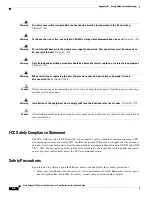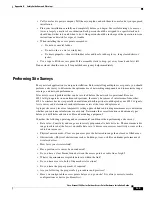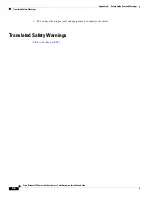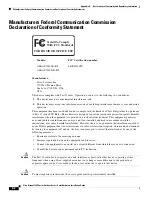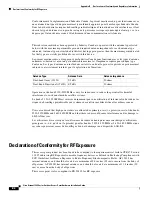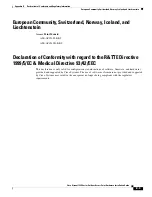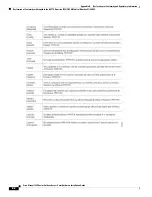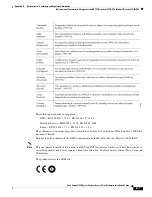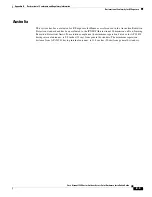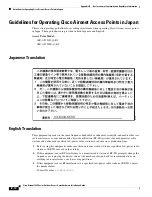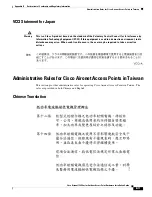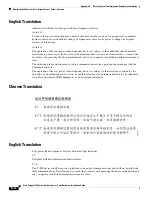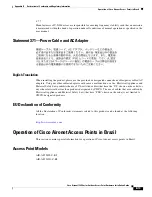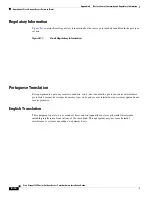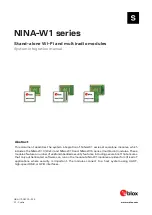
A-3
Cisco Aironet 1540 Series Outdoor Access Point Hardware Installation Guide
Appendix A Safety Guidelines and Warnings
•
Call your electric power company. Tell them your plans, and ask them to come look at your proposed
installation.
•
Plan your installation carefully and completely before you begin. Successful raising of a mast or
tower is largely a matter of coordination. Each person should be assigned to a specific task and
should know what to do and when to do it. One person should be in charge of the operation to issue
instructions and watch for signs of trouble.
•
When installing the access points, remember:
–
Do not
use a metal ladder.
–
Do not work on a wet or windy day.
–
Do dress properly—shoes with rubber soles and heels, rubber gloves, long sleeved shirt or
jacket.
•
Use a rope to lift the access point. If the assembly starts to drop, get away from it and let it fall.
If an accident should occur, call for qualified emergency help immediately.
Performing Site Surveys
Every network application is a unique installation. Before installing multiple access points, you should
perform a site survey to determine the optimum use of networking components and to maximize range,
coverage, and network performance.
Site surveys reveals problems that can be resolved before the network is operational. Because
802.11a/b/g/n operates in an unlicensed spectrum, there may be sources of interference from other
802.11a wireless devices (especially in multi-tenant buildings) that could degrade your 802.11 signals.
A site survey can determine if such interference exists at the time of deployment.
A proper site survey involves temporarily setting up mesh links and taking measurements to determine
whether your antenna calculations are accurate. Determine the correct locations and antenna types
before you drill holes and route cables and mounting equipment.
Consider the following operating and environmental conditions when performing a site survey:
•
Data rates—Sensitivity and range are inversely proportional to data bit rates. The maximum radio
range is achieved at the lowest workable data rate. A decrease in receiver sensitivity occurs as the
radio data increases.
•
Physical environment—Clear or open areas provide better radio range than closed or filled areas.
•
Obstructions—Physical obstructions such as buildings, trees, or hills can hinder performance of
wireless devices.
•
How far is your wireless link?
•
Has a previous site survey been conducted?
•
Do you have a clear Fresnel zone between the access points or radio line of sight?
•
What is the minimum acceptable data rate within the link?
•
Do you have access to both of the mesh site locations?
•
Do you have the proper permits, if required?
•
Are you following the proper safety procedures and practices?
•
Have you configured the access points before you go onsite? It is always easier to resolve
configurations or device problems first.
Summary of Contents for AIR-AP1542D-*-K9
Page 6: ...Contents vi Cisco Aironet 1540 Series Outdoor Access Point Hardware Installation Guide ...
Page 11: ...xi Cisco Aironet 1540 Series Outdoor Access Point Hardware Installation Guide Figyelem ...
Page 13: ...xiii Cisco Aironet 1540 Series Outdoor Access Point Hardware Installation Guide ...
Page 16: ...xvi Cisco Aironet 1540 Series Outdoor Access Point Hardware Installation Guide ...














